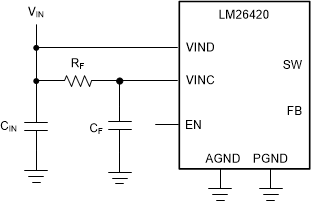SNVSB35B May 2018 – June 2020 LM26420-Q1
PRODUCTION DATA.
- 1 Features
- 2 Applications
- 3 Description
- 4 Revision History
- 5 Pin Configuration and Functions
- 6 Specifications
- 7 Detailed Description
- 8 Application and Implementation
- 9 Power Supply Recommendations
- 10Layout
- 11Device and Documentation Support
- 12Mechanical, Packaging, and Orderable Information
Package Options
Mechanical Data (Package|Pins)
Thermal pad, mechanical data (Package|Pins)
Orderable Information
8.1.2 VINC Filtering Components
Additional filtering is required between VINC and AGND in order to prevent high frequency noise on VIN from disturbing the sensitive circuitry connected to VINC. A small RC filter can be used on the VINC pin as shown in Figure 29.
 Figure 29. RC Filter On VINC
Figure 29. RC Filter On VINC In general, RF is typically between 1 Ω and 10 Ω so that the steady state voltage drop across the resistor due to the VINC bias current does not affect the UVLO level. CF can range from 0.22 µF to 1 µF in X7R or X5R dielectric, where the RC time constant should be at least 2 µs. CF must be placed as close to the device as possible with a direct connection from VINC and AGND.